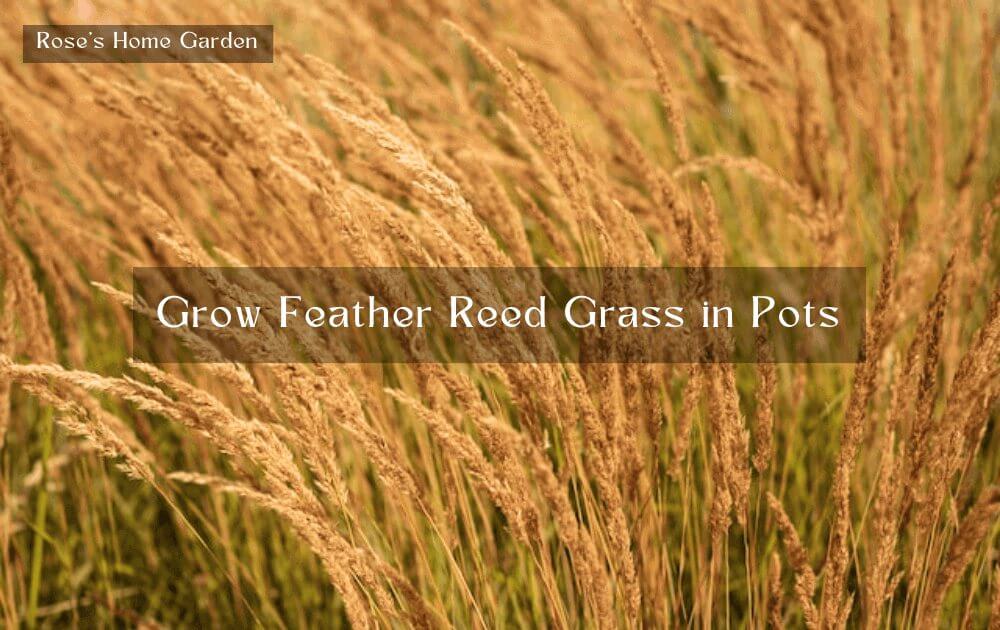
Can You Grow Feather Reed Grass in Pots Indoors? 9 Steps to Grow
Are you longing to add a touch of natural beauty to your lovely home garden? Growing some beautiful plants in pots can be an excellent option! Yet, not all plants are suitable to grow indoors in pots, and some require specific conditions to thrive. Feather Reed Grass, a beautiful ornamental grass with feathery plumes, is a popular choice for outdoor landscaping, but can you grow Feather Reed Grass in pots indoors? The answer is yes!
Just imagine the delicate sway of this elegant grass, its feathery plumes swaying gently in the breeze of your home. In today’s blog, we are gonna discover the possibilities of growing Feather Reed Grass in pots indoors, maybe in your terrace garden, kitchen garden, or balcony. We’ll share some useful tips and tricks to help you bring the beauty of nature inside and create a warm and inviting atmosphere. So, let’s get right into it now!
Can You Grow Feather Reed Grass in Pots? 9 Steps
Feather Reed Grass, also known as Calamagrostis acutiflora, is a beautiful ornamental grass that is commonly used in outdoor landscaping. But yes, you can grow this lovely grass in pots indoors with proper care and attention. The grass prefers a cool environment with bright, indirect sunlight and consistent humidity levels.
While growing Feather Reed Grass in pots indoors can be a bit of a challenge, the rewards are well worth it. With its graceful plumes and natural charm, Feather Reed Grass can transform any indoor space into a tranquil oasis. Let’s try our hand at indoor gardening and add a touch of outdoor beauty to your home with this delightful ornamental grass.

Step 1: Select a Container to Grow Feather Reed Grass
To grow Feather Reed Grass in pots, you have to choose the best suitable pot (container) considering a few factors. Firstly, it’s important to choose a pot that has good drainage holes to prevent water from accumulating at the bottom of the container, which can lead to root rot.
Secondly, the pot should be large enough to allow the roots to spread and develop properly. It should be at least 12 inches in diameter and 12 inches deep. You should also select a pot made of a porous material, like terracotta or clay so that air can circulate the roots and soil won’t become compacted.
Step 2: Choose the Best Soil for Feather Reed Grass
You have to choose the right soil for the health and growth of Feather Reed Grass in pots indoors. The ideal soil mix for this ornamental grass should provide adequate drainage, aeration, and nutrients for the roots to thrive. Below are 4 tips that will help you make the best soil to grow Feather Reed Grass in pots:
- Use a well-draining soil mix: Feather Reed Grass prefers Loamy soil that is moist enough but not waterlogged. Using a well-draining soil mix prevents excess water from becoming logged around roots, preventing root rot.
- Add organic matter: Incorporating organic matter such as compost or peat moss into the soil mix can help improve drainage, increase soil fertility, and enhance the soil’s ability to retain moisture. To learn composting at home, click here
- Avoid heavy soils: Clay-rich soils tend to compact over time, preventing air and water from moving through them, so it’s a good idea to avoid using them. Feather Reed Grass prefers loose, well-aerated soil, so make sure you choose it.
- Consider adding perlite or sand: Adding perlite or sand to the soil mix can help improve drainage and increase aeration, which can benefit the roots of Feather Reed Grass.
In summary, the best soil mix to grow Feather Reed Grass in pots indoors should be well-draining, rich in organic matter, loose, and well-aerated. Loamy, well-drained soil with a 6.0 to 8.0 pH is great for them!
Step 3: Feather Reed Grass Seeds vs Nursery Plants
When it comes to growing Feather Reed Grass in pots indoors, both seeds and nursery plants can be viable options. However, each of these options has its advantages and disadvantages, so it ultimately depends on your preferences and experience.
Seeds:
- Growing Feather Reed Grass from seeds can be a cost-effective option
- Requires more time, patience, and attention than planting a nursery plant
- Feather Reed Grass seeds may also have lower germination rates
- The plants grown from seeds may not look exactly like the parent plant
Nursery Plants:
- Purchasing a nursery plant can save time and effort
- The plant is already established and can be transplanted directly into the pot
- More likely to have predictable growth patterns and the desired characteristics
- However, they can be more expensive than seeds
Step 4: Plant the Grass
Gently remove the Feather Reed Grass from its nursery container and place it in the center of the pot. Make sure the top of the root ball is level with the soil surface, then backfill with soil, gently tamping it down as you go. Water the plant immediately after planting, thoroughly soaking the soil until water runs out of the drainage holes.
Step 5: Right Conditions to Grow Feather Reed Grass in Pots
Feather Reed Grass thrives in cool temperatures and bright, indirect sunlight. Place the pot in a location that receives at least 6 to 8 hours of sunlight per day, but avoid direct sunlight that can burn the leaves. Regular misting of the plant or use of a humidifier is recommended as it will help maintain consistent humidity levels.
Step 6: Regularly Water Your Feather Reed Grass
Regular watering is very important to grow Feather Reed Grass in pots indoors. Before watering the plant, check the soil’s moisture level by sticking your finger about an inch deep into the soil. Does it feel dry? Start watering.
When you water, make sure to thoroughly saturate the soil until water runs out of the drainage holes at the bottom of the pot. This ensures that the roots receive enough water and prevents salt buildup in the soil. Don’t make the soil waterlogged as it can cause root rot and other plant diseases. Don’t let the plant sit in standing water.
Step 7: Fertilize and Groom Your Feather Reed Grass
Feather Reed Grass benefits from regular fertilization during the growing season. So, you can use a slow-release fertilizer formulated for ornamental grasses and apply it once a month, following the manufacturer’s instructions.
Regular grooming is also important to maintain the plant’s appearance and promote healthy growth. Simply groom it regularly by trimming any yellow or dead leaves. Use sharp, clean scissors or pruning shears and make clean cuts close to the base of the plant.
Step 8: Divide the Feather Reed Grass Plant Every Few Years
Feather Reed Grass can become crowded and stressed in a pot, so it’s a good idea to divide the plant every few years. To do this, carefully remove the plant from the pot and gently separate the root ball into smaller sections. Replant each section in a new pot with fresh soil mix.
Step 9: Watch for Feather Reed Grass Pests and Diseases
Feather Reed Grass is relatively resistant to pests and diseases, but it’s still important to watch for any signs of problems. Common issues include rust, leaf spot, and aphids. Steps should be taken with fungicides or insecticides as soon as you notice any problems.
Grow Feather Reed Grass in Pots Indoors with This Guide
In conclusion, growing Feather Reed Grass in pots indoors can be a rewarding experience that adds natural beauty and texture to your home decor. By following these 9 growing steps, you can easily create a healthy and thriving condition for Feather Reed Grass.
Remember that to grow Feather Reed Grass in pots indoors requires patience, attention, and care, but the result is a stunning plant that adds life and vitality to any room. We hope you can too enjoy the beauty in your home. Happy Gardening!


